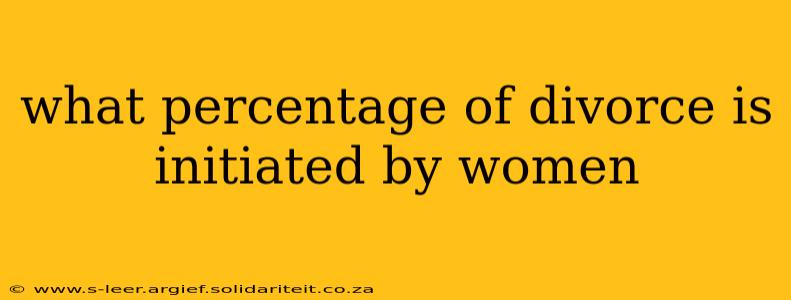What Percentage of Divorces Are Initiated by Women?
The question of who initiates divorce is complex and doesn't have a single, universally applicable answer. While various studies have attempted to quantify this, the results often vary depending on factors like the country, the time period studied, and the methodology used. There's no definitive, globally agreed-upon percentage.
However, research consistently suggests that women initiate divorce more frequently than men in many parts of the world. While it's difficult to provide an exact percentage, studies often show women filing for divorce in a range between 60% to 70% of cases. This is a significant majority, indicating that women are more likely to take the initiative to end a marriage.
It's crucial to understand that these numbers don't represent the reason behind the divorce. They only reflect the party who legally initiates the proceedings. The underlying causes of marital breakdown are multifaceted and involve both partners. Many factors influence a divorce, and assigning a single cause or culprit is an oversimplification.
Why is this statistic often debated?
The perceived disparity in divorce initiation rates between men and women is frequently debated due to several factors:
- Data Collection Methods: The way data is collected significantly impacts the results. Some studies rely on self-reporting, which can be subject to bias. Others may use court records, which might not capture all separations. Discrepancies in methodology make direct comparisons challenging.
- Cultural and Societal Influences: Societal norms and expectations regarding gender roles can influence who formally files for divorce. In some cultures, women might face greater social stigma or legal barriers to initiating divorce, even if they are the ones primarily desiring separation.
- Definition of "Initiation": Even the definition of "initiation" itself is nuanced. Does it refer to the person who files the paperwork, the person who first expresses dissatisfaction, or the one who ultimately makes the decision to end the marriage? Different studies use varying definitions, leading to inconsistencies in findings.
- Time Period: The prevalence of women initiating divorce can vary over time, reflecting societal shifts and legal changes.
What factors influence who initiates a divorce?
Numerous factors play a role in who initiates a divorce:
- Unhappiness and dissatisfaction: The primary driver is usually dissatisfaction with the marriage, stemming from various issues such as infidelity, communication problems, financial stress, or incompatibility.
- Power dynamics: The relative power and autonomy of each partner within the relationship can affect who takes the lead in ending it.
- Legal and financial considerations: Access to resources and legal support can influence who feels empowered to initiate the legal process.
- Children and family considerations: Concerns about child custody and support arrangements can also influence the decision of who initiates the divorce.
Does the initiating party always indicate fault?
Absolutely not. Initiating a divorce doesn't automatically imply blame or fault. One partner might be the one to formally file for divorce, yet both partners may have contributed to the marriage's breakdown. It's crucial to avoid making assumptions based solely on who initiated the legal proceedings.
In conclusion, while women initiate a higher percentage of divorces than men, precise figures remain elusive due to methodological challenges and varying cultural contexts. Focusing on understanding the underlying causes of marital breakdown, rather than solely on who files for divorce, offers a more nuanced and helpful approach to addressing this complex issue.
